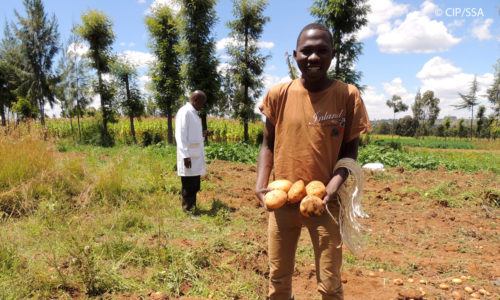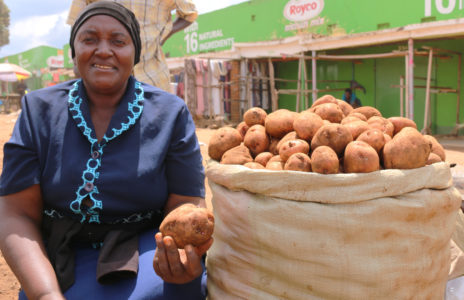
Virus screening and elimination are necessary steps to prevent the spread of diseases when moving plant material from place to place. However, these measures can cause long delays in the release of new varieties. This project seeks to develop improved methods for disease detection, as well as phytosanitary cleaning of plant material that speed up the process of producing high-quality, disease-free stock for breeding trials and for farmers.
Background
Plant diseases build up in tuber crops like cassava, sweetpotato and yam, leading to significant decreases in productivity. Disease-free stock can increase yields by around one third and confer significant benefits on farmers’ food security and incomes. However, stringent and prolonged phytosanitary measures need to be carried out before new germplasm can be tested, multiplied and released to farmers, and this delays the overall dissemination process. Current phytosanitary cleaning of germplasm in root and tuber crops can take more than two years. This project aims to improve the accuracy, speed, and efficiency of virus detection and elimination in cassava, sweetpotato, and yam.
Objectives
The project seeks to produce disease-free planting materials by improving tissue culture techniques, enhancing assessment of virus eradication, and refining procedures for virus detection and diagnosis.
Approach
The two-pronged approach aims to produce disease-free plants by:
- optimizing virus cleaning of planting material through the more rapid development of virus-free in-vitro plantlets and testing the efficacy of the application of antiviral compounds as an additive in growth media or a greenhouse treatment pre-induction into in vitro; and
- accelerating the diagnosis of viruses in planting material through the development of a hand-held portable virus detection instrument, QuickChip, and the improvement of small RNA sequencing and assembly methodology (sRSA). sRSA is a new method that utilizes genome sequencing technology to detect a plant’s response to virus infection. Evidence to date by CIP indicates tapping into the plant’s biochemical response to virus infection is one of the most sensitive assays for detection of virus infection in plant.
The team comprises scientists from the International Institute of Tropical Agriculture, the University of Wisconsin-Madison, and the University of Helsinki, in conjunction with counterparts from national agricultural research systems in sub-Saharan Africa, with a focus on the development of technologies to benefit breeders and farmers on the African continent. Many African national germplasm collections are conserved in field banks which are susceptible to infection by viruses and other pathogens. Simple and reliable protocols will enable these programs to maintain clean germplasm.
Expected outcomes
The principle outcome is to accelerate detection and elimination of viruses in plant materials for the dissemination of virus-free cassava, sweetpotato and yam planting materials in half the time, thereby enhancing efficiency and reducing costs.
Improved production of clean in-vitro plants is expected to lead to the routine dissemination and availability of disease-free plantlets in a greatly reduced time frame.
The team is testing commercially available antiviral compounds for their effectiveness in the rapid development of virus-clean planting material. Lessons learned from this activity will aid the development of antiviral therapies for cassava, sweetpotato and yam to accelerate the time required in obtaining virus-free plants by 50%.
QuickChip is a portable and highly–reliable tool that can be used in the field, nursery or laboratory to quickly and inexpensively detect known viruses in plants. It comprises a chip preloaded with all the reagents needed to detect 11 different viruses found in sweetpotato, yam and cassava and utilizes the power of analytical software from a handheld unit to amplify and detect viral sequences. If the viral sequence is present, QuickChip will detect it. Field testing of QuickChip is planned to start during 2019.
The team will also develop methods to screen compounds that inhibit a single enzyme from one of the viruses causing sweetpotato virus disease (SPVD)—the most important disease affecting the crop. SPVD is very hard to control as it is caused by a synergistic interaction between two relatively benign viruses: the aphid-transmitted sweetpotato feathery mottle virus and the whitefly-transmitted sweetpotato chlorotic stunt virus.
The novel approach taken by the project team is to develop a high throughput screen for compounds which inhibit an enzyme crucial for the synergistic interaction, thereby preventing the occurrence of SPVD. The compounds have been identified and testing in plants is ongoing.
Finally, the team will validate the sRSA technology, while concurrently improving the software, VirusDetect. The software unscrambles millions of tiny RNA sequences to identity the viruses present in the plant. sRSA is now fully operational and is currently being tested side-by-side with conventional virus indexing procedure. It is hoped that by 2020 sRSA will replace the costlier and more time-consuming virus indexing procedure now in use and provide certification of disease-free status four times more quickly than previously possible.
The improved VirusDirect will make the software more user friendly through the adoption of a Windows-based format which will be easily downloaded and used by scientists globally in environments without access to reliable high-bandwidth internet services.
All data produced by the project will be open access.
Key outcomes
- Acceleration of the time required for sweetpotato and yam virus cleaning by 50% .
- Development of sRSA into a cost-effective and rapid ISO-certified replacement for sweetpotato, yam and cassava virus indexing.
- Adaptation of VirusDetect for facilitated and easy use by partners globally.
- Successful field testing of QuickChip for sweetpotato, yam and cassava viruses.
- Identification, characterization, and testing of chemical inhibitors of SPVD.
Contact
David Ellis, CIP, Peru • d.ellis@cgiar.org
Jan Kreuze, CIP, Peru • j.kreuze@cgiar.org
Noelle Anglin, CIP, Peru • n.anglin@cgiar.org
Thanks to our donors



